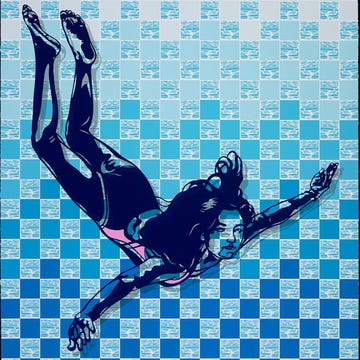On a bright June morning, I sit beside multidisciplinary artist Sunny Moon Atema in a small booth—a simple frame of plywood and boards, bright with fresh pink paint—overlooking Goat Mountain at Highway Sanctuary, a five-acre experimental art site in Yucca Valley, as she encourages me to yawn.
To Atema, yawning is infinite and profoundly connective. Mammals, birds, reptiles, even fish yawn. She imagines yawns traveling in the most unlikely places: a window washer passing one to a boardroom of executives, or a woman at dinner spreading it to the busser clearing plates. “This involuntary breath can pass between enemies or strangers,” she says.
No one has pinned down exactly why we yawn; scientists have floated theories about brain cooling, arousal, and social bonding. Studies suggest that simply seeing, hearing, or even reading the word yawn can be enough to trigger one. (Try not to yawn while reading this—I dare you.) While babies and young toddlers yawn, the social reflex of contagious yawning usually appears later, around ages four to six. To explore the concept of contagious yawning, the Yawning Booth contains a built-in cassette player that allows visitors to listen to Atema’s prerecorded yawns. “It’s like a telephone booth,” Atema wrote on her website. “Instead of communicating words, one gives and receives yawns.” Seated inside a mosaic structure, visitors can either indulge in a yawn or try to stifle one as they engage in a connective—and contagious—experience.
Atema, based in Joshua Tree, works across music, painting, and installation. Performing under the name Wildlife Freeway, she released her debut album, Sunny, in 2022, a collection of two-chord guitar songs and piano compositions carried by Atema’s incantatory vocals and unique inflection. She will perform these ballads next month at the Joshua Tree Music Festival. In 2018, Atema self-published her Animal Medicine Cards, a set of illustrated cards accompanied by a poetic guidebook. Now in their sixth edition, the cards provide insights drawn from everyday creatures—a spider, for instance, urging you to consider the webs you weave in your own life.
The first Yawning Booth, which played looped recordings of Atema’s yawns, appeared in 2012 at the arts organization Pioneer Works in Brooklyn’s Red Hook neighborhood. Only a few months after its installation, Hurricane Sandy nearly swept the structure out to sea. In 2013, she re-created the piece for Dial Collect, a group exhibition at SOMArts Cultural Center in San Francisco. This time, she added a live video feed: a camera capturing each visitor’s yawn and projecting it elsewhere in the gallery, relocating the sources of contagion from bodies to screens.
In October 2024, Atema began her third Yawning Booth—a permanent installation opening September 13. She often rose before sunrise to begin work, mixing cement and piecing together cast-off tiles. “I’ve never dedicated so many hours to a single piece,” she tells me. She poured her first cement slab, anchored the frame, and layered the structure in waterproof tile paint and wire before setting the mosaic: pastel pinks, soft whites, muted blues, and flashes of green and amber tiles pieced together into an irregular yet intentional skin.
By August, when I visited again, the booth had transformed—layer by layer, tile by tile—into a glittering temple, nearly seven feet tall and four feet wide. Atema’s black circle portal had been installed with tile on one wall (the portal is a feature in many of her works, this one suggestive of an open mouth). Two benches: one within the structure, facing a vast expanse of desert, where visitors experience the yawning, and another, a blue mosaicked seat, facing the opposite direction. Atema learned mosaic from the founder of Highway Sanctuary, though the finished work is unmistakably Atema’s, marked by the imprints of her hands.
Unlike the earlier iterations, which closed visitors in, this booth opens to the horizon. Framed by mountains, mesa, and sky, it belongs to the desert itself. “In the High Desert, people come to connect with the stars and the universe through plant medicine,” Atema says. “Many folks say they ‘get the yawns’ on mushrooms, but maybe it’s possible to bypass [hallucinogens] altogether and enter an expanded consciousness simply through catching yawns.”
This, frankly, sounds like a more relaxing trip. Maybe that’s the point—connection doesn’t always arrive through intensity but through the ordinary. The desert has long drawn seekers testing the boundary between body and spirit; Atema’s booth suggests that the threshold might be as simple as a shared breath. On my second visit, I let out a wide, unguarded yawn and wondered if this most familiar reflex might also be the body’s quietest invitation to connect.•
YAWNING BOOTH
Opens September 13, 2025
Highway Sanctuary
1101 Old Woman Springs Rd., Yucca Valley
Jennifer Lewis is the editor in chief and publisher of Red Light Lit, a small press and reading series established in 2013. She is the author of the short story collection The New Low, published by Black Lawrence Press.













